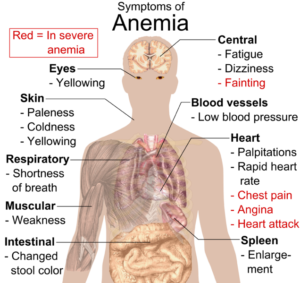Anemia: The Symptoms and Causes You Need to Know
Anaemia, also known as anaemia of iron deficiency or sideropenic anaemia, is a common type of anemia characterised by a decrease in the number of red blood cells (RBCs) or the amount of haemoglobin in the blood. Common symptoms of anaemia include fatigue, weakness, pale skin, and shortness of breath. In women, other symptoms include irregular menstrual cycles, decreased libido and decreased fertility. Anaemia affects people of all ages, genders, and nationalities, but is especially common in developing countries, affecting as many as one in four people worldwide.
The two most common types of anemia, iron deficiency anemia and anemia of chronic disease, are caused by different conditions, but they can have similar symptoms. Iron deficiency anemia is caused by a lack of iron intake or ability to absorb iron into the body. Iron is an essential mineral required for the production of healthy red blood cells (RBCs), so when the body is unable to get enough iron, it is unable to produce enough RBCs and hemoglobin. Insufficient intake of dietary iron, decreased ability to absorb iron, and/or increased loss of body iron through menstruation or bleeding are the primary causes of Iron Deficiency Anemia.
Anaemia of chronic disease is a less common type, but is caused by lifestyle factors such as chronic illnesses and infections, cancer, kidney disease and other medical conditions. The substances released by the body’s immune system in response to these medical conditions can disrupt the production of RBCs, leading to anaemia.
Regardless of the type, the symptoms of anaemia are similar, and most often include fatigue, weakness, pale skin, and shortness of breath. In women, other symptoms may include irregular menstrual cycles, decreased libido and decreased fertility. Those suffering from anaemia can also experience headaches, coldness in the extremities, dizziness and chest pain. An individual’s symptoms may vary, depending on the type and severity of their anaemia. Additionally, pregnant women may experience more severe anaemia due to the increased demand for iron by the growing fetus.
The good news is, the treatment of anaemia is quite simple. A balanced diet that contains iron-rich foods, such as lean red meats, seafood, dark green leafy vegetables, dried fruits, and iron-fortified cereals, can often help. Iron supplements can also be prescribed by a doctor to help treat iron deficiency anaemia. Additionally, a doctor can help diagnose and treat any underlying medical conditions that may be causing anaemia of chronic disease.
In conclusion, Anemia is a common, but often overlooked, type of anemia. It is characterized by a decrease in the number of RBCs and/or hemoglobin in the blood, and can cause symptoms such as fatigue, weakness, pale skin, and shortness of breath. The two


Comments